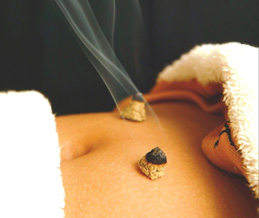
(It is normally used on acupuncture points, so it can also be used to treat people who are scared of the idea of having acupuncture.)
Moxa is made by drying, crushing and sifting the leaves of a special herb (Artemisia argyi). The use of moxa is an important part of any acupuncture training, and we use it in most acupuncture treatments we perform at our clinic.
There are said to be over 50 methods of using moxa, but the main techniques we use are:
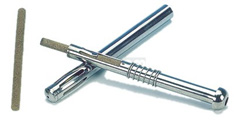
Tiger Warmer
It is important to realise that the warmth from moxa has a completely different effect on the body to other types of heat. There has been plenty of research into how moxa produces its effects on the body, and many theories have been put forward, but there are no clear answers yet. Originally it was thought that the essential oils in the plant may have produced the benefits, but now it is believed that the unusual frequency of the far infra-red heat produced by the smouldering moxa causes the changes.
For rice-grain moxa, we only use the highest grade from carefully selected, superior quality plants gathered from the Ibuki Mountain in Japan during midwinter. This moxa consists of the hairs from the leaves of the plants, and is so pure that virtually no smoke is produced when it burns. This grade is known as ‘Gold moxa’ due to its colour (and possibly its scarcity and price!).
For cone and warm-needle treatments, we use Extra Pure Wakakusa Grade moxa, a very high quality moxa from the leaves of the plant.
Moxa has been used as part of acupuncture treatments for around 3,000 years, and some people believe that it was even used to treat people before acupuncture was developed. In Japan, it is traditional for a child to receive a moxa treatment from the head-man of their village whenever they have a birthday, to ensure good health for them.
After World War II, the Americans occupied Japan, and banned the use of acupuncture and moxa, believing them to be barbaric and primitive practices. They had no idea how much opposition they would encounter! Traditional practitioners banded together and mounted a massive campaign, enlisting the help of doctors and scientists who understood the value of these practices. After a long legal battle, the therapists prevailed, and so these practices survived.[1]
In Japan, moxabustion (treatment by burning moxa) is considered a therapy in its own right, and there is separate registration for acupuncturists and moxabustionists. However, most acupuncturists incorporate some degree of moxa treatments in their practice. It is common in Japan for acupuncturists and moxabustionists to teach their clients how to perform simple moxa treatments on themselves at home for their condition, and platform or ‘stick-on’ moxa is commonly sold in various shops as a form of self-treatment. The person sticks the small cylinder of moxa on the painful spot, lights it, and removes it when the right level of warmth is felt.
So if you notice a light smoky smell when you come to the clinic, you know that someone has just enjoyed moxa as part of their treatment.
For more information about moxa and how it may be able to help you, please talk to Peter or one of our other acupuncturists.
[1] Practical Moxibustion Therapy, by Junji Mizutani, R.Ac., 1998
Several of our Brisbane acupuncturists attended a seminar recently on the latest developments in Japanese acupuncture. There were some excellent new treatments, including one for chronic pain that is not improving with regular treatment. It is called the DLPFC treatment, and treats the part of the brain that relates to long-term pain (the Dorsolateral Prefrontal Cortex). The belief is that sometimes this part of the brain can get ‘stuck’ and keep registering the pain even after it has gone. The treatment is designed to help this part of the brain to switch off so that the person stops experiencing the old pain.
This treatment is not for everyone; it only works in cases where the condition has already been treated but the pain is still there. Having said that, some of our clients with very stubborn pain are reporting great results.
If you think that you may be a candidate for this treatment, please book in for an Assessment with Peter.
An Australian trial of acupuncture in our hospitals has found the therapy is more effective than morphine when it comes to relieving acute pain.
Here are the full details of the study, showing that the “Success rate was significantly different between the 2 groups (92% in the acupuncture group vs 78% in the morphine group).”

The main symptom of adrenal exhaustion is constant tiredness, but because the body gets very run down it can often cause stress, irritability, depression or anxiety. The immune system is very sensitive to your energy levels, so immune weakness, allergies, or auto-immune diseases can develop. Adrenaline is part of your hormone system, so adrenal exhaustion can also cause all types of hormone imbalances, including PMS, menopause symptoms, thyroid problems, or low libido. Poor sleep and digestive problems are also very common symptoms.
Adrenal Exhaustion is a quiet health epidemic that is becoming increasingly common. In fact, it may surprise you to learn, that adrenal exhaustion is an underlying factor in almost all illnesses. Adrenal exhaustion is often caused by an overly stressful and busy lifestyle. The links between problems with the adrenal gland and excessive stress are well-known but recent research also suggests they can be exacerbated by poor diet, caffeine and smoking. Because adrenaline is the body’s ‘fight or flight’ hormone, the body is very sensitive to there being too much or too little of it in the blood stream. Almost any type of stress, whether it is physical or psychological, will cause an increase in adrenaline levels.
In this fast paced age, we hear that every minute counts. Day after day, week after week, all this pressure to achieve, meet goals, finish daily tasks, begins to build up inside of us until one day we are locked in the throes of time pressure. A chief contributor to time pressure is emotional identity. This happens when you invest a great deal of mental and emotional energy in a situation. All that energy can create tunnel vision, leaving you unable to see or appreciate other important things in your life. When someone or something interferes with that focus, the result frequently is irritation, anxiousness and frustration, especially when deadlines must be met. You push people away, neglect other areas of your life, but still proceed until eventually you lapse into emotional chaos. In the end, time pressure can seriously damage not only your relationships and quality of life, but even the situation in which you buried yourself to the exclusion of all else. Time pressure takes a toll on our nervous, immune and hormonal systems, and left unattended will likely produce cycles of anxiety, fatigue and temporary despair. As this process continues it makes us more susceptible to health problems.
Always rushed, too much to do, not enough time; mentally scattered, not feeling in control, tunnel vision, irritation at anyone or anything that breaks your focus, internal pressure, a gnawing feeling in you solar plexus, impatience, lack of compassion for self and others, feeling a constant slow burn inside, low-grade stress and strain, feeling disconnected from life, decreased enjoyment of projects, relationships or life in general.
Other causes of adrenal exhaustion are
When treating Adrenal Exhaustion, it is important to address 3 areas.
If you suspect that you may have Adrenal Exhaustion, please book in for a free Comprehensive Assessment so that we can check and let you know if you do, and inform you on how best to treat it.

‘It was 2005, and after nine months of IVF treatment and a positive pregnancy test, 36-year-old Jill King was having a routine ultrasound to check that all was well. But when she turned to the screen, expecting to see a heartbeat, there was just an empty embryonic sac. In a cruel biological hoax, the sac minus its embryo – called a blighted ovum – was causing positive signs of pregnancy. There were more disappointments to come. By the time she discontinued IVF two years later, King had produced 50 embryos, but no babies, at a cost of about $50,000.
“People talk about the grief of miscarriage, and I’ve experienced that, but to me each embryo was also a potential baby lost,” she recalls. “Whenever I had an embryo transfer [where the embryo is passed through the cervix into the uterus], I’d be calculating when its birthday might be.” …
“My message to other couples is be open-minded about alternative treatments,” says King. …
Some cases of unexplained fertility may have a cause that is overlooked if IVF is used as a first, rather than a last, resort, says Dr Anne Clark, medical director of Fertility First, a clinic in Sydney’s Hurstville.
Being overweight, smoking or drinking too much – even a lack of vitamin D or iodine – can sabotage conception or increase the risk of miscarriage, points out Clark. While the clinic offers IVF treatment, 25 to 30 per cent of couples conceive without it after correcting certain lifestyle factors.
“Women are hammered for being overweight or for smoking, but we know that with men, nine kilograms of extra weight can lower fertility by altering hormone levels,” she says. “We also know that fragmentation of DNA in male sperm is a common cause of miscarriage, and that factors such as smoking, alcohol and possibly caffeine may be contributing.”
Her study in 2008 of 800 men who were attending Fertility First found 58 per cent had sperm damage, but that lifestyle changes and vitamin supplements could help prevent this. “Unlike eggs, which are as old as the woman herself, sperm is freshly made every three months,” says Clark. “Because of this, you can often reverse the problem quickly.”
This was the case for Matthew Lake, a 34-year-old landscaper whose partner, Amanda, had had three miscarriages by the time she was 29. Test results showed she had no obvious problem, but Matthew had fragmented DNA in 33 per cent of his sperm.
At Clark’s suggestion, he reduced his weekly beer consumption from 24 to seven, stopped drinking Coke and took a daily multivitamin. He also took supplements of coenzyme Q10 and vitamins E and C, antioxidants that, according to some research, help reduce sperm damage.
“After six months, the number of fragmented sperm had dropped to nine per cent – a month later I was pregnant,” says Amanda. “I don’t think people realise the problem can often be with the male partner, and that the solution can be simple.”
In Clark’s experience, men are often only asked to provide a sperm sample, and if that is problematic, the couple are directed to IVF rather than addressing a man’s underlying health problems. The pressure of ageing impels couples towards IVF, too, she says.
Francesca Naish, from the Jocelyn Centre for Natural Fertility Management in Sydney, agrees. “People are in a hurry to conceive, but they need to take about three months to clean up first.”
The “cleaning up” regimen recommended by the centre, which employs medical practitioners, naturopaths and an acupuncturist, entails both partners eating whole food – preferably organic – taking herbs and vitamin and mineral supplements, and reducing exposure to environmental toxins.
“Take the example of a hairdresser or a motor mechanic,” says Naish. “She’s exposed to bleaches and solvents, and he’s working with solvents, heavy metals and paints. This doesn’t mean hairdressers and mechanics can’t make babies together, but if their fertility is already compromised, these exposures can make conception – especially of a healthy baby – harder.” Other workers who come into contact with pesticides, such as farmers, may experience problems, too, explains Naish, as can people who spend a lot of time flying (sperm and eggs can be affected by radiation at high altitude). Some studies have linked heavy mobile phone use to reduced sperm count and sperm health. In isolation, these factors may mean nothing, but an accumulation of them, plus increasing age, can make a difference.
Although there’s evidence that the miscarriage rate is higher with IVF, says Naish, “this isn’t necessarily to do with IVF technology, which is fantastic. Miscarriages can occur because other problems aren’t being sorted out first,” she says. “IVF helps sperm and egg to meet and then gets the fertilised egg to the uterus, but it doesn’t solve underlying problems that can impede a pregnancy.”
Anne Clark acknowledges that with IVF offering a monthly pregnancy rate that is two to three times higher than nature, it will always appeal to couples in the stressed-out 21st century. When she recommends waiting until the lifestyle changes kick in, some couples feel pretty thrown to begin with. “But achieving a pregnancy can be a bit like painting a wall.” she says. “It’s all in the preparation.”
The Role of Folate
Dawn Piebenga knew getting pregnant in her late 30s wouldn’t be easy. “I’d had a history of fertility problems in my 20s and early 30s with my first marriage. I was told that it may be because of scar tissue around my Fallopian tubes.”
When a pregnancy in her second marriage ended in miscarriage, she consulted fertility expert Francesca Naish. “Because I was older, I knew my egg quality wouldn’t be as good, so I felt my best shot was to make my body as healthy as possible,” she says.
Tests revealed that Piebenga had a problem shared with about one in eight women: difficulty metabolising folate, a B vitamin that helps prevent some birth defects. At 39 and after four months on a preconception-care program and a high-dose folate supplement, Piebenga got the go-ahead to try to conceive. She became pregnant within a month, and now has a 15-month-old son.
(End of article.)
Natural therapists consider that a woman’s periods can reflect how well her hormones and reproductive system are working. So one of the aims of any course of treatments is to help improve her periods as much as possible, which may include the timing and length of the period, making sure the flow is not too heavy or too light, and treating any period symptoms (in conjunction with normal medical treatment).
Acupuncture
It is becoming more common for our acupuncturists to work in conjunction with medical fertility specialists whilst a woman is undergoing ART (Assisted Reproductive Technologies such as IVF, IUI and ICSI). There is continuing research about how acupuncture can assist with the effectiveness of IVF treatment, and there is also broad agreement by acupuncturists and other health practitioners about using acupuncture in these cases. Please contact our Principal Practitioner if you would like to find out if acupuncture may be able to assist in regard to your specific situation.
The outcome of acupuncture for fertility Brisbane treatments depends on the skill and expertise of the therapist, and on the methods that they use. We only use Japanese acupuncture techniques at our clinic, since when performed by a highly-trained therapist, we have found this style to be more effective that the standard Chinese acupuncture. (All of our acupuncturists were originally taught Chinese acupuncture, but since being trained in the Japanese style they now only use that method.)
Naturopathy
Naturopathy is the use of natural medicines (such as high potency supplements, herbal treatments, diet therapy, etc.) and may be able to assist with many fertility and women’s health issues. Naturopathic medicine involves looking after the chemistry of the body, including improving essential nutrition levels and reducing toxin levels. It aims to improve hormone health, as well as helping to regulate periods, cycle length and ovulation times.
Naturopaths are qualified health professionals with a 4 year degree.
If you are trying to conceive, looking to start trying in the next 12 months, or are going through IVF, we recommend having a Comprehensive Fertility Assessment by our Principal Practitioner. During your Assessment we will identify and explain to you
It is recommended that you and your partner each have an Assessment, and if possible sit in on each other’s appointment. An Assessment is normally $120, but is currently available free of charge. There is no obligation with an Assessment; we simply provide you with information and an understanding of what is happening with your body. Places for a Fertility Assessment are limited, so if you would like to reserve an appointment for you and your partner, please ring or email soon. Please also feel free to contact the Clinic if you would like more information about any aspect of fertility improvement, and we look forward to helping you soon.
[1] http://www.smh.com.au/lifestyle/life/natural-selection-20091221-l9l1.html#ixzz2i8UBRhgM
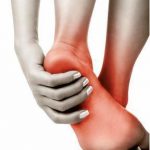
Your sinuses are a magnificent structure of tunnels and caves running throughout your head that connect to your respiratory system. The body does not have good access into the sinuses, so they often become the site of what is called a ‘focal infection’. This is an infection in which bacteria are localised in some region (such as the tonsils or the tissue around a tooth), from which they may spread to other organs or tissues in the body. Sometimes your immune system keeps the focal infection under control, but does not completely eliminate it. Because of its nature to “hide out”, you many not notice any symptoms from the infection. However, the low-grade inflammation becomes a source of irritation for the body, inflaming connective tissues such as tendons and ligaments, as well as depressing the immune system, so that other types of inflammatory processes such as bladder irritation, digestive problems or period pain may keep occurring.
With any condition, it is always important find out the full picture of how the person’s body is working, and then treating the causes as well as the symptoms. Otherwise, good long-term results are unlikely.
Hip pain is often caused by a problem with the alignment of the body. It can often be caused by a misalignment of the feet (such as an old ankle injury) or from the lower back. We frequently find that our clients have hips that are twisted, tilted or raised on one side. Because your spine is supported by your pelvis, if your hips are not in the correct position your spine will have to compensate, so it can cause problems almost anywhere along your spine, but especially in your lower back or neck. Just as the hips are used to balance the lower body, the shoulders are used to balance the upper body, so if the hips are out often the shoulders will be out as well.
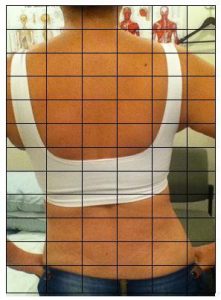
Another possible cause of hip problems is the liver. The liver is on the right side of the body, underneath the lower ribs, and sometimes if the liver gets congested or irritated, the muscles over it can become tight, particularly below the right shoulder blade. (You can see a little of this in the above photo.) This can then pull the right hip up or the right shoulder down, putting the body out of alignment, and could cause lower back, hip, neck or shoulder problems.
So for structural problems,
With the right diagnosis and treatment, the majority of back, neck, hip and shoulder problems can become a thing of the past.
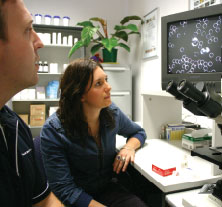
I do not believe that conventional medicine always has all the answers. We receive a constant stream of clients coming to us who have been to their doctor or specialist, who haven’t been able to identify what their problem is, or are unable to provide a satisfactory solution for them. Many of these are chronic conditions such as digestive problems, immune problems (including allergies and food intolerances), period problems, fertility, long-term pain, constant fatigue, and a variety of significant chronic diseases, such as diabetes, etc. Natural therapies work by IMPROVING the body and how it is working, to allow the body to heal itself.
As a very basic example, if someone is constantly suffering from colds and flu, we would improve their immune system to help prevent that happening in the future. Since the immune functions are strongly connected to the digestive system, this may involve improving their digestive system also. Conventional medicine usually works on relieving the symptoms rather than improving the body, whereas we believe in treating the causes of the problem as well as the symptoms. Side-effects from natural therapies are very rare, and if you can solve a patient’s health problem naturally, without resorting to drugs or surgery, I think they will usually be better off.
So there is a place for both approaches, hence the term ‘Complimentary Medicine’ for natural therapies. Obviously there will be many cases where conventional medical treatment is important, and there will also be many cases where natural therapies work best. The ideal is for both camps to work together for the highest good of the patient. Hence we have patients referred to us by doctors, and we refer some of our patients to doctors as well.
There are a number of doctors who specialise in ‘Nutritional and Environmental Medicine’, which is virtually what naturopaths do. Please check out the website www.acnem.org/about/what-is-nem for some basic information about the approach of these doctors (and of naturopaths). There are also many doctors who only use acupuncture to treat their patients, or use it in conjunction with conventional medical treatment. I personally have two colleagues who are doctors but choose to practice natural therapies instead, and four other colleagues who practice both as GPs and as natural therapists. So the two approaches are not mutually exclusive.
As you can see, these days naturopaths and acupuncturists are starting to be recognised as genuine health professionals.
It is also worth noting the following.
As is the case with all primary care health professionals, it is important that natural therapists can determine when a patient needs to be referred to a medical doctor. This is an essential part of naturopathy and acupuncture courses, and is also a key part of providing the best possible care for your patient.
Every health professional will have their own methods of evaluating the body. For example, a dentist, physio or an optometrist will perform a different examination on a patient to a GP. Our approach to health problems is different to that of medical practitioners, since our aim is to improve the patient’s body so that it can correct the problem itself. To sort out a patient’s health, we first need to be able to evaluate how their body is functioning. Some of the things we may wish to check can be determined by blood tests, so we may request that a patient obtain one if we need to evaluate their iron levels, cholesterol, thyroid hormones, ESR, check their kidney function, etc.
However, there are many things that are important to us that a blood test or scan cannot determine, such as if the patient has low levels of stomach acid (a common cause of many digestive problems), the extent of man-made toxins in their liver, the extent that stress is affecting their nervous system, if they have a chronic sub-clinical sinus infection or small intestinal bacterial overgrowth (SIBO), etc. So naturopaths and acupuncturists have developed their own systems of evaluating the health of different aspects of the body, including whether a particular organ is overactive or underactive. Of course, if something showed up as a serious concern, we would refer that patient to a GP for the appropriate medical tests as well.
The Japanese palpation assessment can be used to quickly evaluate how well the digestion, liver, immune system, thyroid, adrenals, large intestine, lungs, and nervous system are functioning. It also indicates the level of toxins in the body, how good the patient’s internal circulation is, their level of stress and anxiety, structural alignment issues, hormonal imbalances, and blood sugar imbalances. It can also be used to confirm the improvements that are taking place in the patient’s body from their treatments.
The ancient Chinese actually knew a fair bit about the body and how it works. For example, they discovered that the heart pumped blood continuously around the body 2,000 years before it was discovered in the west.
The ancient Chinese had a great healthcare system. Everyone would be under the care of a local therapist (acupuncturist or herbalist), and you paid your therapist while you are well, and stopped paying them when you were not! This not only made healthcare more affordable, but also placed a heavy emphasis on the therapist preventing any diseases developing in their patients.
Unfortunately, Australia is currently heading towards a future health ‘crisis’, with an ageing population and government medical costs increasing rapidly. In the US, it is predicted that by 2025, chronic diseases will affect 49% of the population. People with chronic conditions already account for 81% of hospital admissions, 91% of all prescriptions filled, and 76% of all doctor visits. Australia is expected to follow the same path; people are living longer, but are more likely to suffer from disease and poor health in their later years. Because natural therapies focus on improving the body and increasing the patient’s health, they can play a huge role in the prevention or improvement of many illnesses. (I sometimes jokingly tell my clients that my job is to put the nursing homes out of business.)
Thanks for your interest in this topic Andy. Natural therapies are such a huge area that it is only possible to cover some very basics in a forum such as this. Some things are also far easier to demonstrate than to describe, so if you would like to find out more and experience what we do, it would be worthwhile booking in with us for a free Comprehensive Assessment.
Acupuncture reduces stress, which increases fertility
When people are under stress, the hormone cortisol is released in the brain. This disrupts hormone levels, and that in turn impacts fertility – in fact, stress can stop ovulation entirely or cause spasms in the uterus and fallopian tubes (preventing implantation). Acupuncture releases endorphins, which counters the effects of cortisol and reduces stress.
If you’d like to learn more about the use of acupuncture for fertility, we’d love to hear from you – you can get in touch with us here.
Do you suffer from indigestion, reflux, bloating, heartburn, irritable bowel, diarrhoea, gas, stomach pain, or stomach cramps? A common belief is that reflux, heartburn and GORD/GERD are caused by too much stomach acid, and so antacid products are now a multi-billion dollar industry. However, too much acid production is actually relatively rare, and around 90% of these problems are caused by not having enough stomach acid instead! Your body is totally dependent on the nutrients from your food, so if your digestive system is not working well, every part of your body will struggle.
Your stomach processes your food so that your intestines can break it down further and absorb all the nutrients. When functioning properly, the stomach produces a powerful hydrochloric acid, with a pH (acidity level) of 1.5 to 3.0. This is strong enough acid that if it were dropped onto a piece of wood it would burn a hole through the wood. The inner lining of the stomach is protected from its own acid by a thick layer of mucous, and epithelial cells that produce a bicarbonate solution to counteract the acid. Stomach acid serves 5 main purposes. It
The stomach also produces intrinsic factor, which binds to vitamin B12 and allows it to be absorbed in the small intestine. Vitamin B12 is an essential nutrient for the formation of red blood cells.
Your stomach is also a muscle, and it churns up the food and mixes it with the hydrochloric acid and enzymes. It is very common for stress to affect the muscles in the stomach.
This mixing the acid through the food continues until the mixture (called chyme) reaches the right pH, and this triggers the stomach muscles to move it into the small intestine. The high acidity of the chyme then triggers the release of other digestive enzymes from the pancreas (to continue with the digestive process) and sodium bicarbonate (to neutralize the chyme and prevent it from burning the small intestine).
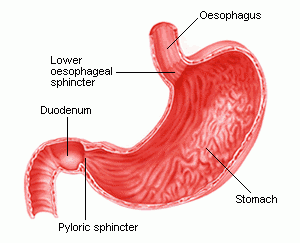
The stomach has two valves, the lower esophageal sphincter (LES) at the top of the stomach, and the pyloric sphincter at the bottom. The pyloric sphincter is a one way valve, however the LES at the top is designed to open both ways. When too much pressure builds up in the stomach, but the pH is still not acidic enough for the pyloric sphincter to open, the body has only one option to release the pressure: opening up the LES. The release of the pressure into the esophagus causes the symptoms of heartburn and acid reflux. Even if you have low stomach acid, any amount of this acid going from the stomach into the esophagus will cause discomfort or pain, because your esophagus was never designed to handle stomach acid. If this happens regularly, the LES becomes weakened, making the problem worse.
Other causes of LES problems can include overeating, overweight or obesity, pregnancy, hiatal hernia, and many medications (including anti-inflammatories, antibiotics, bronchodilators, beta-blockers, antidepressants, and anti-anxiety drugs).
Low stomach acid also causes digestive problems downstream from the stomach in the small intestine. If the stomach is not able to produce enough acid to bring the pH level of the chyme to the correct level, eventually the stomach will be forced to move it through the pyloric sphincter into the small intestine. Because it is not at the proper pH, the chyme does not trigger the release of sodium bicarbonate, which can cause duodenal ulcers. The lower acidity of the chyme also doesn’t trigger the release of pancreatic enzymes. The small intestine is then not able to break down the chyme properly, and the large, undigested particles of food can disrupt the lining of the small intestine. The lining becomes more permeable, and allows the undigested food particles to enter your bloodstream, where your body’s immune system believes them to be foreign invaders instead of food. This triggers a systemic immune response that can lead to food sensitivities, inflammation, and autoimmune diseases (such as rheumatoid arthritis, Hashimoto’s thyroiditis, Graves’ disease, lupus, type 1 diabetes, or multiple sclerosis (MS)). This condition is known as leaky gut syndrome.
Some undigested food particles may continue into the large intestine, and this malabsorbed food can disrupt the normal gut flora. The large intestine may become inflamed and conditions such as constipation, diarrhoea, or irritable bowel syndrome could develop. Having the correct gut flora is also crucial for a good immune system.
Because low stomach acid can have such a profound impact on your overall health, the symptoms can affect many parts of your body. They can include
Heartburn
GORD/ GERD
Indigestion and bloating
Burping or gas after meals
Excessive fullness or discomfort after meals
Constipation and/or diarrhoea
Chronic intestinal infections
Undigested food in stools
Food allergies, intolerances, and sensitivities
Acne
Chronic fatigue
Mineral and nutrient deficiencies (including iron and/or vitamin B12 deficiency)
Dry skin or hair
Weak or cracked nails
Asthma
Depression
Osteoporosis
Any autoimmune disease
An American doctor, Jonathon Wright (author of the book “Why Stomach Acid is Good for You”), measured the stomach pH of thousands of patients in his clinic, and found that 90% of them had too little stomach acid. Stomach acid levels are said to decrease with age, but like many ‘age-related’ issues, low stomach acid can be corrected naturally with the right treatment.
As you can see, medications and drugs that suppress stomach acid are not an effective, safe, or smart way to address the causes of heartburn, indigestion or acid reflux, and over time can end up making these conditions worse instead.
Apple cider vinegar (ACV) can help stimulate stomach acid production. If you are not used to the taste and effects of ACV, it is best to include it into your diet gradually.
Apple cider vinegar is very acidic, so you need to dilute it to protect your teeth, throat and the lining of your stomach. Don’t drink undiluted ACV.
We have a brand of ACV at the clinic which we recommend.
If you have any digestive issue, please call now to book in for a complimentary Health Assessment with our Brisbane Naturopaths. We can then see what is going on in your body, what is working properly and what is not working properly, what is causing the problem, and how it can be resolved naturally.
Wright, J. & Lenard, L. (2001). Why Stomach Acid is Good for You: Natural Relief from Heartburn, Indigestion, Reflux, and GERD. Lanham, Maryland, The Rowman & Littlefield Publishing Group.

Valued at $120, your Assessment will help to uncover:
All this will be fully explained to you, and you can ask as many questions as you like. That way we can be sure to give you all of the right information, understanding and advice you need. Terms and conditions: This is a free, no obligation offer.